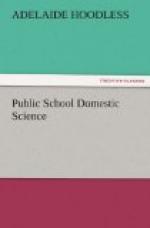CHAPTER VIII.
Fruits.
Fruits are composed largely of water, with starches, a vegetable jelly, pectin, cellulose and organic acids. The most important acids in fruit are citric, malic and tartaric. Citric acid is found in lemons, limes and oranges; tartaric acid in grapes; malic acid in apples, pears, peaches, apricots, gooseberries and currants. Among the least acid are peaches, sweet apples, bananas and prunes. Strawberries are moderately acid, while lemons and currants contain the most acid of all.
Uses of Fruit.
(1) To furnish nutriment; (2) to convey water to the system and relieve thirst; (3) to introduce various mineral matter (salts) and acids which improve the quality of the blood; (4) as anti-scorbutics; (5) as laxatives and cathartics; (6) to stimulate the appetite, improve digestion and provide variety in the diet. Apples, lemons and oranges are especially valuable for the potash salts, lime and magnesia they contain. Fruit as a common article of daily diet is highly beneficial, and should be used freely in season. Cooked fruit is more easily digested than raw, and when over-ripe should always be cooked in order to prevent fruit poisoning.
NUTS.
Nuts contain proteid, with some starch and sugar, but are not considered valuable as nutrients. Cocoanuts, almonds and English walnuts are the most nutritious.
Beverages.
TEA.
Tannin is an astringent of vegetable origin which exists in tea, is also found in coffee and wines, and is very injurious. Tea is a preparation made from the leaves of a shrub called Thea. The difference between black and green tea is due to the mode of preparation, and not to separate species of plant. Green tea contains more tannin than black. The following table will show the difference:—
=======================+===================+===========
======== | GREEN TEA. | BLACK TEA. -----------------------+-------------------+----------------
--- Crude protein | 37.43 | 38.90 Fibre | 10.06 | 10.07 Ash (mineral matter) | 4.92 | 4.93 Theine | 3.20 | 3.30 Tannin | 10.64 | 4.89 Total nitrogen | 5.99 | 6.22 -----------------------+-------------------+----------------
---
The stimulating properties which tea possesses, as well as its color and flavor, depend upon the season of the year at which the leaves are gathered, the variety of the plant, the age of the leaves, which become tough as they grow older, and the care exercised in their preparation. Much depends upon the manner in which tea is infused. (1) Use freshly boiled water; (2) allow it to infuse only three or four minutes, in order to avoid extracting the tannin. When carefully prepared as above, tea is not considered unwholesome for people in good health.




